September 2024
Fig.1
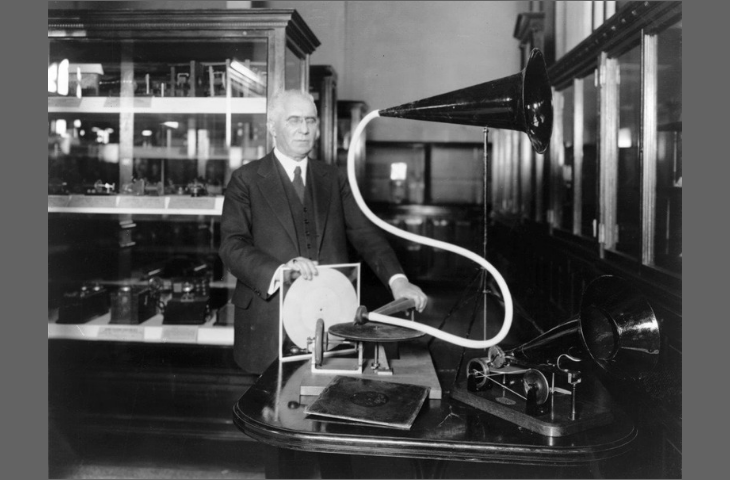
Emile Berliner and his first gramophone (©Library of Congress Online Collection)
Fig.2
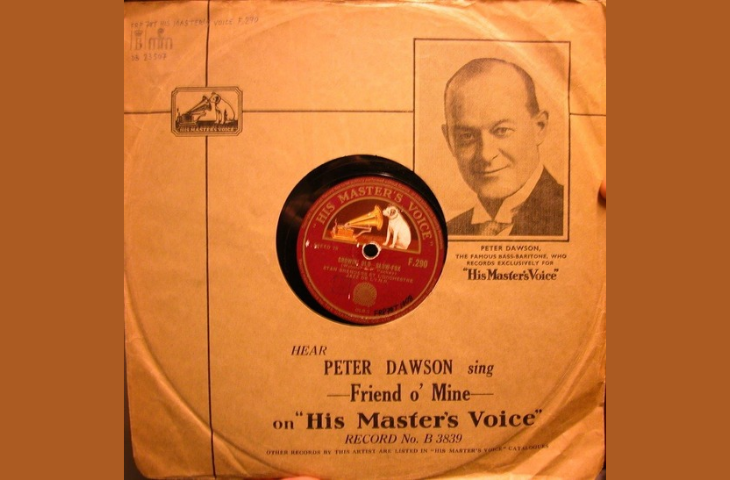
78 rpm record His Master’s Voice from the Robert Pernet’s collection : Stan Brenders & INR orchestra
Fig.3
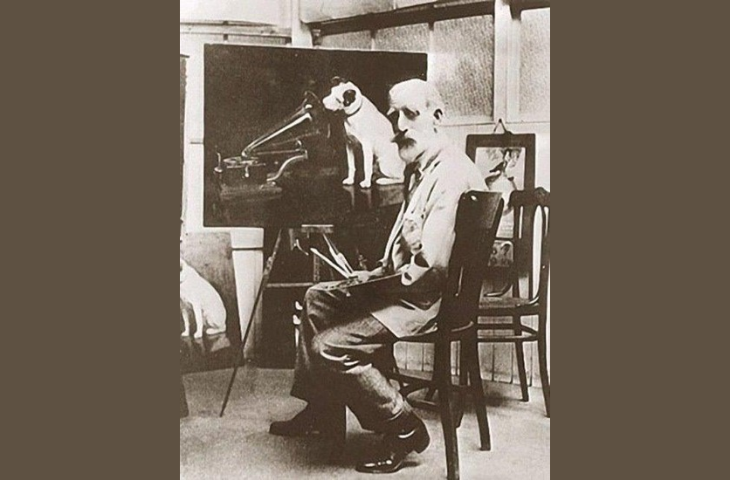
Francis Barraud and his painting « His Mater's Voice » (©Wikipedia)
Fig.4
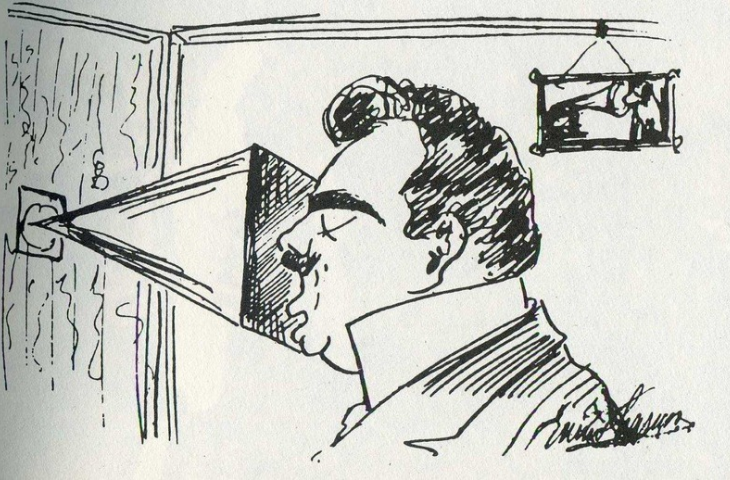
Caruso singing in a recording horn (©Wikimedia)
Fig.5
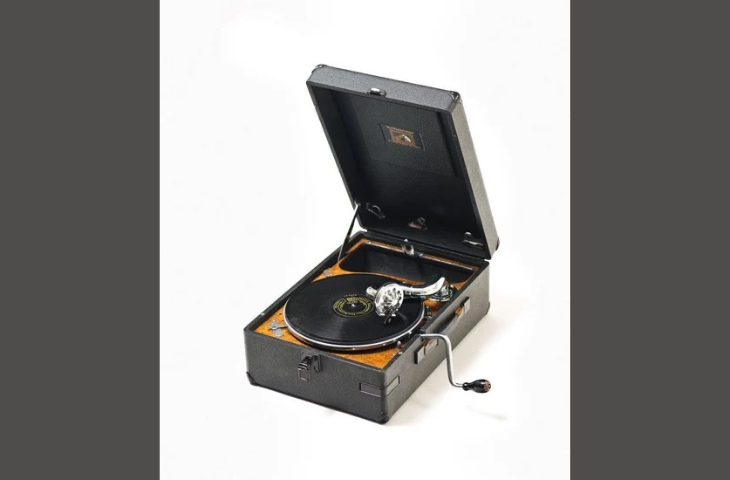
MIM's HMV 102 portable gramophone, Gramophone Company Ltd, Great Britain, ca 1935, inv. 2018.0089 (donation Vincent Verhaeren)
In 1887, the German engineer Emile Berliner (Fig.1), who had emigrated to the United States, perfected Edison's 1877 phonograph and developed the gramophone. The name comes from an inversion of "phonogram", which means "recording of a sound". The main innovation was to record the sound on a flat disc instead of a cylinder. The groove is engraved horizontally, making the needle oscillate sideways. Edison was not afraid of this newcomer, claiming that the sound was more accurate and cleaner with the vertical engraving of his phonograph.
Yet the public has many reasons to prefer discs to cylinders. They were cheaper because they were easier to mass-produce, more durable, more manageable, easier to store and could hold up to 6 minutes of music with both sides, twice as much as an Edison cylinder. Until the end of the 19th century, cylinders and records were in competition, before the record gradually became the world standard.
After the first attempts with wax and glass discs, they were made of zinc covered with wax which was then immersed in an acid bath to fix the groove in the metal. But the metal support caused quite a lot of sound interference. From 1897 onwards, these materials were replaced by shellac, a natural plastic made from the secretion of the Asian cochineal, resin, and wood dust. The discs were first turned at a speed of 90 revolutions per minute, then standardised at around 78 revolutions. Shellac was the basis of the 78-rpm record industry (Fig.2) and was replaced in the 1940s by a synthetic plastic: vinyl.
With the growing success of the disc, labels and companies proliferated. The history of the Gramophone Company and its subsidiaries, between the United States and Europe, is a veritable mess of names, bankruptcies, successes, mergers and splits. However, the record company will forever be remembered for its famous 'His master's voice' logo, which depicts a dog listening to a phonograph horn as if it was hearing 'his master's voice'. This is the work of the painter Francis Barraud (Fig.3), who was moved by Nipper, his late brother's Jack Russell. While trying to sell his painting to the phonograph companies, he went to the Gramophone Company in London where he was bought for the princely sum of £100 (the equivalent of €10,000 today!), but was asked to replace the phonograph with a gramophone. This is how it became one of the most recognisable trademarks in the world.
The Gramophone Company's other masterstroke was to attract to the record the great voices who had previously been rather reluctant to entrust their art to the recording horn. Since the stars are reluctant to come to the studio, let's go to them! Equipped with his recording equipment, acid tanks and a large quantity of matrices, the production manager Fred Gaisberg (1873-1951) set off in 1899 to make recordings all over the world. In 1902 he stopped off in Milan to attend an opera evening where he discovered the tenor Enrico Caruso, who left him speechless. Caruso agreed to sing ten romances for the gramophone for a fee of £100, an astronomical sum for barely two hours' work (Fig.4)! But success and future contracts would bring much more. Until then, most people did not have the opportunity to hear these artists perform. What man in the street could afford the luxury of an evening at La Scala or Covent Garden? Now you can enjoy all these glories in your living room. The gramophone is gradually taking pride of place. It even became a piece of furniture among the others in the living room, with a large pavilion and usually a cupboard to store the records.
It was in the 1910s and especially during the First World War that the first portable gramophones came out, also called "trench gramophones", entertaining soldiers at the front. With the rise of the automobile after the war, they were called "suitcase" or "picnic" gramophones, because they were taken with them on trips, during family outings on Sundays or outings with friends.
The HMV 102 portable gramophone was the last acoustic and fully mechanical gramophone to be made (Fig.5). The case is opened and the tone arm unfolded. The crank is removed from its storage to reassemble the spring mechanism that will turn the platter. We place the record, delicately put the needle on it, and the magic happens! The vibrations picked up by the needle are converted into sound waves by the diaphragm. The sound then travels through the tone arm into a conical cavity in the case and is amplified through the opening between the platter and the cover, which acts as a sound reflector (video).
Because of the long production run of the HMV 102, it was the most prolific of all the Gramophone Company's products, being available with few changes from 1932 to 1958, until the electric record player superseded it for good. That of the mim dates from 1935.
Text: Matthieu Thonon